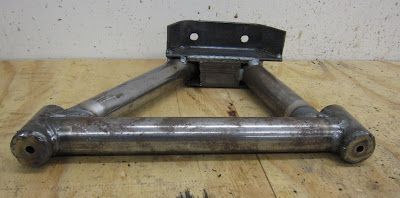I also built a bracket to brace the manifold to the block. The turbo is pretty heavy, and the manifold will hold a lot of heat. Nearly all factory turbo setups are braced to the block, so I am hoping this will help to prevent any future issues. I only want to build this once!
 |
| The bends are lightly tacked in place just to get the project started. |
 |
| It is kind of like a puzzle.. there were known angles I had to have, and then I just had to fill in the missing pieces. |
 |
| All the tubes are notched and fitted reasonably well and tacked together. |
 |
| Nearly all welded up. |
 |
| Bolted to the spare cylinder head - keeps the manifold from warping when welded. |
 |
| That is the support brace tab on the bottom of the manifold. |
 |
| Support brace - it's not very pretty, but it'll definitely do the job. I did not have a long enough piece of flat steel on hand, so I had to use a portion of round pipe to make it work. |
 |
| This is how it all sits in the chassis. |
 |
| Everything is bolted down on the engine - even installed the gaskets! Hopefully I won't be taking this off again any time soon. |










































